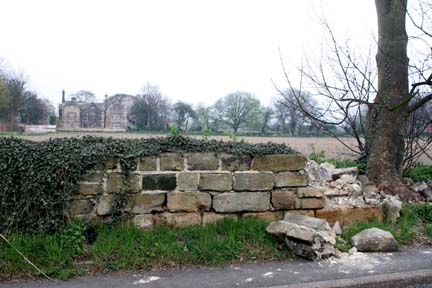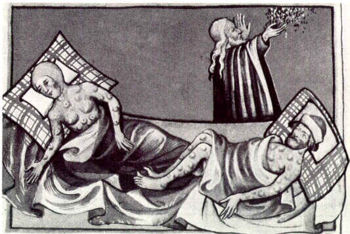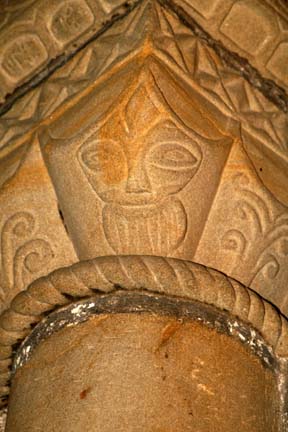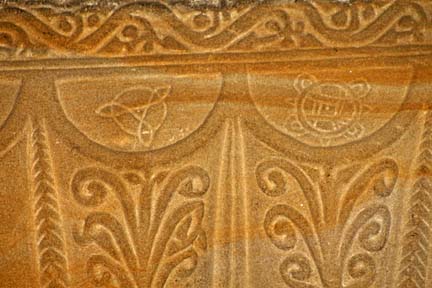Part 4
As we move on into the 14th century building seems to have come
to a standstill perhaps due to the extensive work programme recently
completed. A certain family named de Hoderode whose head was Richard, a
knight, appear regularly in the Nostell chartularies making gifts of land
to the Priors to save their souls and those of their descendants as was
the custom. John the son of Richard de Hoderode granted the Priors more
land between what is now Kirkgate and High Wel l
Lane and also the permission to build a wall above their ditch to encircle
their culture completely. This wall can still be seen today – rather worse
for wear and tear (see photograph left - Hodroyd Hall in the
background).
l
Lane and also the permission to build a wall above their ditch to encircle
their culture completely. This wall can still be seen today – rather worse
for wear and tear (see photograph left - Hodroyd Hall in the
background).
More interestingly, John gave the priors all his rights in the church’s
land in Hoderode without retention. They afterwards leased him the land
for life for one pound of Frankincense payable on the day of the church’s
festival. Business acumen!
It wasn’t only Hoderode that gave to the priors of Nostell for protection
in the after-life, Ryhill, Cold Hiendley, and Shafton all had landowners
who helped Nostell to flourish by indulgences. This came to an abrupt end
in 1348 as the Black Death plaque (see illustration below right)
made in-roads into the population of England its ravages carried off one
third of humanity. Following the plague re-modelling and extending of
churches throughout the country to offer th anks
to God for deliverance from the plague and to enlarge his house at Felkirk
like so many more Abbeys and parishes were doing. The following building
programme was very extensive and appears to have been carried out in three
stages, which did not reach completion until 150 years later at least.
Yes, it does seem improbable but the three stages were not carried out in
continuity, stonemasons, carpenters and other workers came and went. If
the king needed them elsewhere they could not refuse to go. These people
still had to grow their own supplies, feed their own stock, work ten days
for the church and the Lord of the Manor. After the king, the last two
took precedent over everything else particularly at the harvest time and
to crown it everyone gave one tenth or tithe to the incumbent for the
upkeep of the church itself. It is not an easy task to look at the church
and say definitely which stage was begun first because the architecture is
so similar throughout this period and I am by no means a professional
person trained in this subject, looking at the building logically,
particularly on the inside, I would suggest that the first stage was to
replace the existing apse with a long rather narrow chancel not as high as
the one which exists now but with a temporary east window of the new
coloured glass to increase the lighting. The Norman style pillars and
decorative stonework at the entrance to the apse would be left on site
until further notice development was envisaged.
anks
to God for deliverance from the plague and to enlarge his house at Felkirk
like so many more Abbeys and parishes were doing. The following building
programme was very extensive and appears to have been carried out in three
stages, which did not reach completion until 150 years later at least.
Yes, it does seem improbable but the three stages were not carried out in
continuity, stonemasons, carpenters and other workers came and went. If
the king needed them elsewhere they could not refuse to go. These people
still had to grow their own supplies, feed their own stock, work ten days
for the church and the Lord of the Manor. After the king, the last two
took precedent over everything else particularly at the harvest time and
to crown it everyone gave one tenth or tithe to the incumbent for the
upkeep of the church itself. It is not an easy task to look at the church
and say definitely which stage was begun first because the architecture is
so similar throughout this period and I am by no means a professional
person trained in this subject, looking at the building logically,
particularly on the inside, I would suggest that the first stage was to
replace the existing apse with a long rather narrow chancel not as high as
the one which exists now but with a temporary east window of the new
coloured glass to increase the lighting. The Norman style pillars and
decorative stonework at the entrance to the apse would be left on site
until further notice development was envisaged.
At the beginning of the 15th century the most
ambitious project ever was planned viz the chancel was to be enlarged to
incorporate a south chapel – or was it a vestry? It was certainly a vestry
in 1875 when the last restoration took place as it was marked upon the
plan. I am inclined to believe that a chapel was in fact the original
intention and did exist until many years later when its use was changed to
that of a vestry perhaps during the reign of
Mary who didn’t care for catholism. So far so good but the piece de
resistance of the ambitious plan was to be a tower at the west end of the
church soaring heavenwards, high enough to be seen above the trees as a
goal for weary travellers. We can assume then that work on the new chancel
began in the last quarter of the 14th century but by the
beginning of the 15th century it was decided that the chancel
should be widened to incorporate a north and south chapel. As in the nave
the south outer wall was replaced two bay arches and the chantry chapel
east end became extended as the new south chapel. The north chapel was a
different situation altogether the outer wall was moved to the north and
the one and one half bay arches were built to replace what was the outer
wall. The sacristy was made smaller by one yard. The truncated roofline is
clearly visible in the sanctuary and outside at the east end the chancel
overrides the sacristy roof. What was the west side of the sacristy wall
is now inside the north chapel with the plinth still in situ inside. The
Norman style decorative arch and the clusters of pillars at the entrance
to the chancel were removed and replaced by the old English style arch,
which is still there today.
The next phase of the tower, which incorporated on the
inside the Norman pillars and capitals from the old chancel arch built on
a plinth and the whole supporting the old English style tower arch. It was
quite an ingenious idea to support the tower arch on these immensely
strong Norman style pillars as they would take the weight of the tower
wall above the arch as the masons proceeded. The capitols of these two
clusters of pillars are decorated in what would appear to be a pr-conquest
style with a floral motif on a frieze round the top. Below the freeze on
the north capitol are carved nine horizontal faces and beneath the faces
can be seen the bearded feat ures
of the “Heathen of the North” (see photograph below right)
to whom the gospel was read when the pillars were in their former
position. The south capitol has a carving of the Celtic sign of the
Trinity (see photograph below left) under the frieze. The
tower itself is approximately twenty feet square internally with a newel
stair in the south west corner giving access to two chambers
originally but the lower one was removed sometime later although the door
shape can still be seen up in the wall. Many of the old chancel arch
stones can be seen in the walls where there conveniently filled a space
during the construction. The exterior is slightly larger to compensate for
the thickness of the walls and each corner was supported by Norman style
buttresses built diagonally and in three steps reaching about thirty feet
high. Fur dripstones encircle the walls to the crenellated top where a
gargoyle
ures
of the “Heathen of the North” (see photograph below right)
to whom the gospel was read when the pillars were in their former
position. The south capitol has a carving of the Celtic sign of the
Trinity (see photograph below left) under the frieze. The
tower itself is approximately twenty feet square internally with a newel
stair in the south west corner giving access to two chambers
originally but the lower one was removed sometime later although the door
shape can still be seen up in the wall. Many of the old chancel arch
stones can be seen in the walls where there conveniently filled a space
during the construction. The exterior is slightly larger to compensate for
the thickness of the walls and each corner was supported by Norman style
buttresses built diagonally and in three steps reaching about thirty feet
high. Fur dripstones encircle the walls to the crenellated top where a
gargoyle
 at
each corner keeps away the evil spirits and deposits surplus water on the
unwary. A large twin-opening door was built into the base of the tower for
some reason or other but much later it was sealed by stonework inside and
outside – another mystery unsolved. Apart from weathering at the top the
tower still graces the building as it did six hundred years ago without
showing any defects in the stonework. The west door was very sturdily made
from oak inside and outside. On the exterior, solid oak boards an inch
thick and the height of the door were fitted vertically to horizontal oak
boards on their inner sides. Weathering has produced an unusual pattern of
the harder parts of the grain, which to me looks quite pleasing and
suggests that the doors were hung for many years before being sealed up.
The ironwork of the hinges and crooks is still rather crude but certainly
substantial and security of the door was a heavy wooden bar,
which fitted across it and ended in two holes in the jambs one on
each side. Many of the decorated stones from the old chancel arch have
been built into the tower walls, diapers and chevrons can be seen placed
ad lib to use them up.
at
each corner keeps away the evil spirits and deposits surplus water on the
unwary. A large twin-opening door was built into the base of the tower for
some reason or other but much later it was sealed by stonework inside and
outside – another mystery unsolved. Apart from weathering at the top the
tower still graces the building as it did six hundred years ago without
showing any defects in the stonework. The west door was very sturdily made
from oak inside and outside. On the exterior, solid oak boards an inch
thick and the height of the door were fitted vertically to horizontal oak
boards on their inner sides. Weathering has produced an unusual pattern of
the harder parts of the grain, which to me looks quite pleasing and
suggests that the doors were hung for many years before being sealed up.
The ironwork of the hinges and crooks is still rather crude but certainly
substantial and security of the door was a heavy wooden bar,
which fitted across it and ended in two holes in the jambs one on
each side. Many of the decorated stones from the old chancel arch have
been built into the tower walls, diapers and chevrons can be seen placed
ad lib to use them up.
About the second half of the 15th century the north aisle in
the nave was created in a similar fashion that the south aisle was created
500 years previously, there was a difference in that it was made higher
than the south aisle perhaps to incorporate a gallery. There are three
arches and a further arch built at the entrance to the north chapel to
match the one on the south chapel. Oddly enough, carved stones were also
built into the outer wall and these can be seen below the window at the
west end outside. I wonder why the large Saxon window head was placed on
the inside of the west walls? Did it serve a purpose? It is anyone’s
guess. The old north door was replaced with one of early Tudor style the
jambs and hood-mould of which can still be seen on the outside of the
north wall. The two windows are also of early Tudor style but they
obviously did not contain stained glass as they do today. More natural
light was required in the interior and in particular if the plan was to
invent a gallery in the north aisle, neither must we forget that natural
light was necessary in the new chapel, which was also given a window.
So by the end of the 15th century the frenzied work began many
years previously gave the parish a beautiful new (almost) building capable
of holding a large congregation of worshippers and possibly being the envy
of the surrounding parishes.
Back to Top of Page